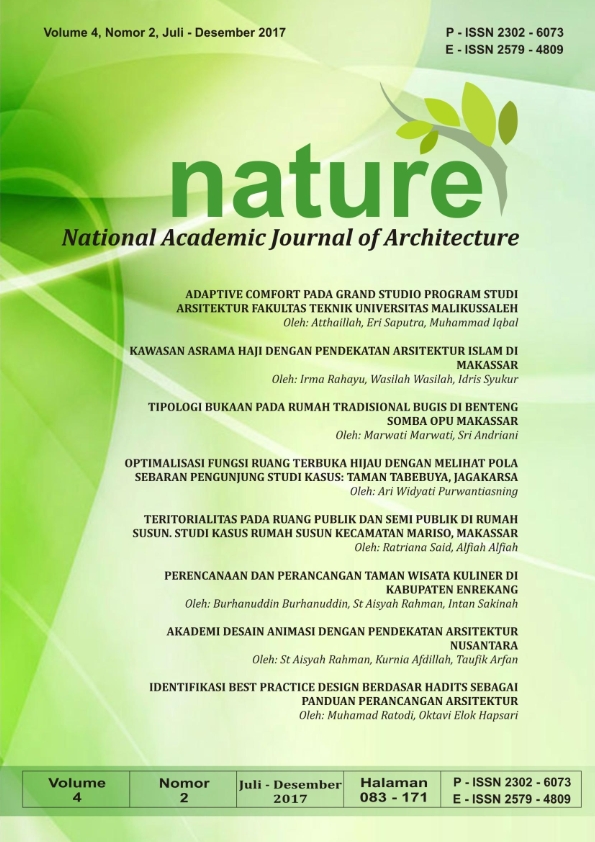ADAPTIVE COMFORT PADA GRAND STUDIO PROGRAM STUDI ARSITEKTUR FAKULTAS TEKNIK UNIVERSITAS MALIKUSSALEH
Abstract
Abstrak_ Ruang Grand Studio Program Studi Arsitektur Fakultas Teknik Universitas Malikussaleh (GS-PAFT) merupakan satu ruang studio baru yang menggunakan penghawaan alami pada prodi Arsitektur universitas tersebut. GS-PAFT merupakan ruang studio yang paling luas yang dapat menampung 60 orang mahasiswa dengan luas 168.48 m2dan baru digunakan satu semester. Dalam penggunaannya, dirasakan kondisi termal yang tidak nyaman baik bagi mahasiswa maupun tenaga pengajar.Studi ini melakukan investigasi untuk membuktikan sensasi ketidaknyamanan subjektif tersebut dengan data sehingga bisa dipertanggung jawabkan secara objektif dengan pengukuran adaptive comfort.Tujuannya adalah untuk memberikan data sensasi termal sehingga pihak prodi arsitektur dapat mengambil langkah yang benar untuk penyelesaian masalah tersebut.Metode yang dipakai adalah metode simulasi komputer dengan teknik parametrik menggunakan Rhinoceros, Grasshopper dan Ladybug & Honeybee.Ruang GS-PAFT dibagi menjadi sembilan zona berdasarkan orientasi dan modul bangunan untuk memudahkan analisis.Simulasi dilakukan dari pukul 08.00 sampai 17.00 yang merupakan waktu pemakaian ruang pada hari kerja.Hasil menunjukkan kurang dari 40% waktu sepanjang tahun dirasakan nyaman.Zona yang paling nyaman dan paling tidak nyaman secara berurutan adalah zona 8 (Timur, tidak terpapar matahari) dan zona 20 (Barat Daya, terekspos matahari) dengan persentase waktu nyaman tahunan 39.23% dan 33.53%. Kata kunci : Adaptive Comfort; Sensasi Termal; Simulasi Kenyamanan Termal; Metode Parametrik; Ruang Studio.
Kata kunci : Adaptive Comfort; Sensasi Termal; Simulasi Kenyamanan Termal; Metode Parametrik; Ruang Studio.
Abstract_ Grand Studio Technic Faculty of Architecture Department in Malikussaleh Uniersity (GS-PAFT) was a latest studio room using natural ventilation on Architecture Department of Malikussaleh University. GS-PAFT was the largest studio which accommodated 60 students with the area of 168.48 m2 and it had been utilized only for one semester. The thermal sensation of the space was uncomfortable both for students and lecturers who had used the studio. Thisinvestigation of this study is to prove the subjective of uncomfortable sensation that can become responsible objective using measurement of adaptive comfort. The paper was aimed for providing data of thermal sensation, in order to guide the architecture department solving the thermal comfort problem. This study used computer simulation method with parametric technic using Rhinoceros, Grasshopper, Ladybug& Honeybee. The GS-PAFT room was divided into nine zones based on its orientation and the building modular for easier analysis. Simulation was conducted from 08:00 A.M. to 05:00 P.M. which was the time of the space was utilized within the working days. The result showed that less than 40% of the time from the whole year was thermally comfortable. The most comfortable and uncomfortable zones consecutively were zone 8 (East, no sun exposure) and zone 20 (South West, sun exposed) which revelead 39.23% and 33.53% the comfortable time percentage of the whole year.
Keywords : Adaptive Comfort; Thermal Sensation; Thermal Comfort Simulation; Parametric Method, Architecture Studio
Downloads
References
ASHRAE Standard 55. 2010. Thermal Environmental Conditions for Human Occupancy. Atlanta: American Society of Heating, Refrigerating and Air-Conditioning Engineers, Inc.
Alozie, G, O.C Ifebi, and M.U Eze. 2015a. "An Assessment of Thermal Comfort in Naturally Ventilated Architectural Studio in Abia State University, Uturu." International Journal of Advance Studies in Engineering and Scientific Inventions 104-108.
Alozie, G, O.C Ifebi, and M.U Eze. 2015. "Thermal Comfort Evaluation of Two Naturally Ventilated Architectural Studios in Akanu Ibiam Federal Polytechnic Unwana Ebonyi State-Hot-Humid Environment." International Journal of Strategic Research in Education, Technology and Humanities 205-212.
Baruah, Plabita, Manoj Kumar Singh, and Sadhan Mahapatra. 2014. "Thermal Comfort in Naturally Ventilated Classrooms." 30th International Plea Conference. Ahmedabad. 1-8.
de Dear, Richard J, and Gail S Brager. 2002. "Thermal Comfort in Naturally Ventilated Buildings: Revisions to ASHRAE Standard 55." Energy and Buildings 549-561.
Groat, Linda, and David Wang. 2013. Architectural Research Methods: Second Edition. Hoboken: John Wiley & Sons.
Kamaruzzaman, Khadijah, and A.S.B Tanzilan. 2012. "Thermal Comfort Assessment of a Classroom in Tropical Climate Conditions." Recent Advances in Energy, Environment and Development 87-91.
Roudsari, Mostapha Sadeghipour, and Michelle Pak. 2013. "Ladybug: A Parametric Environmental Plugin for Grasshopper to Help Designers Create an Environmentally-Conscious Design." 13th Conference of International Building Performance Simulation Association. Chambery; France. 3128-3135.
Santamouris, M. 2006. "Adaptive Thermal Comfort and Ventilation." Ventilation Information Paper 1-8.
van Treeck, Christoph, Jerome Frisch, Martin Egger, and Ernst Rank. 2009. "Model-Adaptive Analysis of Indoor Thermal Comfort." Eleventh International IBPSA Conference. Glasgow. 1374-1381.
Copyright (c) 2018 Atthaillah Atthaillah, Eri Saputra, Muhammad Iqbal

This work is licensed under a Creative Commons Attribution-ShareAlike 4.0 International License.
By submitting your manuscript to our journal, you are following Copyright and License











